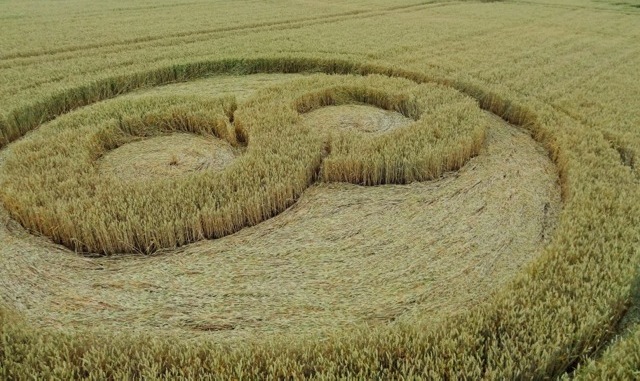Crop Circle Collaboration At Peacedale Preserve
April 1, 2018
Photo of crop circle in a farm field.
In the fall of last year, an elaborate crop circle was identified at Natural Lands’ Peacedale Preserve, in southern Chester County. A portion of the 222-acre preserve is leased to a local farmer, who noticed the trampled wheat but chalked the damage up to vandalism. It wasn’t until Mark Williams, a volunteer drone photographer, was taking images from high above the fields that the symmetry and pattern was discovered.
“Whatever it was, it was beautiful,” said Williams. “I had to recharge the batteries and send the drone back up for a second look!”
This spring, as crops are being planted, Natural Lands is partnering with researchers from the Pennsylvania Crop Circle Coalition to install monitoring devices at Peacedale. The goal is to register and record changes in temperature, sound, and light over the fields.
Researcher Alice Moonwhite described the process the Coalition uses to track evidence of alien-caused vegetation disturbances. “We use spectro-radiometers to track the spikes in wavelengths to provide data on the arrival, duration of work, and departure of the non-human life forms. We’ll also be monitoring changes in the Earth’s magnetic pull during with a triaxial fluxgate magnetometer. Over time, patterns in the data along with the crop circle geometry and their relationship to the astronomical meridian, helps us theorize about the significance of the crop patterns and their meanings,” said Moonwhite.
However, other crop circle experts assert that the formations are the result of scientifically undetectable Earth energy fields and meridians called ley lines. (Though scientists can find no evidence of these ley lines—they cannot be detected by magnetometers or any other scientific device—many insist their energy is palpable.)
Still others believe weather is the cause of these formations. Terence Meaden, a meteorologist, physicist and former professor at Oxford University, has long asserted that the circles are caused by whirlwinds whose course was affected hilly terrain.
Natural Lands’ President Molly Morrison said she and the staff were skeptical at first. “When I first saw the photos from Mark, I certainly wasn’t thinking this was the work of an extra-terrestrial,” she shared. “But my mind is open. I’m willing to be proven wrong. At the very least, Natural Lands wants to do our part to help research efforts.”
 Moonwhite and her colleagues were eager to install their equipment early this spring so that there would be time to adjust and recalibrate before the corn crop has matured. “We want to be able to adjust for wildlife, weather, and human interference. After we get things set just right, we just wait and see. Things look promising based on our initial studies of the 2017 patterns.”
Moonwhite and her colleagues were eager to install their equipment early this spring so that there would be time to adjust and recalibrate before the corn crop has matured. “We want to be able to adjust for wildlife, weather, and human interference. After we get things set just right, we just wait and see. Things look promising based on our initial studies of the 2017 patterns.”
Though the study area is quite a distance from any public trails, visitors to the preserve are asked to keep their distance so as not to disturb the research or trigger false readings.
Please note that today is April First, often known as “April Fool’s Day.”
next post
Stoneleigh: Air Power
April 28, 2017
By Ethan Kauffman, director of Stoneleigh. Work continues at Stoneleigh as we ready the property for its public debut (spring, 2018). Last week, our friends […]
continue reading